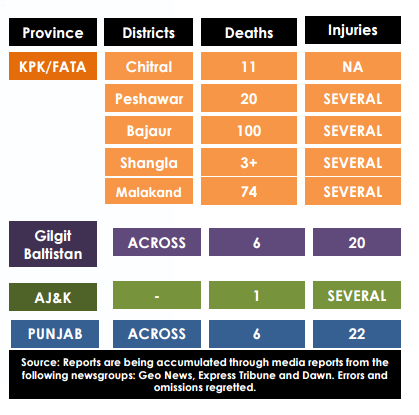Islamabad, Pakistan: Pakistan earthquake death toll rises to 340 as more reports are coming from remote mountainous areas.
Highest number of deaths have been reported from the province of Khyber Pakhtunkhwa, around and maximum number of deaths have taken place in tribal area of Bajaur, around 100 till filling of this report. Over 1,000 people have been reported injured and have been hospitalized in various hospitals over the country. KPK/FATA: Chitral, Peshawar, Bajaur, Shangla and Malakand Division are major areas from where reports are arriving about serious damages.
It may be mentioned that 7.5 magnitude earthquake jolted Pakistan while epicenter was Alaqahdari Afghanistan and depth of earthquake was 212 km inside earth therefore it was deep earthquake and did not cause extreme damage comparing to any shallow earthquake. The location of epicenter was 36.441°N 70.717°E depth=212.5 km (132.1 mi).
Unconfirmed information being gathered in Islamabad suggested that earthquake in Pakistan caused 340 killed, over 2,500 injured in Gilgit, Baltistan, Chitral, Malakand, Para Chinar, Upper Dir, Lower Dir, Swat, Peshawar, Mingora, Shangla Par Alpuri, Shangla valley, and other parts of the country. First earthquake of the day in this region was reported at 9.45 am that came from 42 km East of Farkhar, Afghanistan. This earthquake was reported five hours before devastated earthquake.
USGS in its report suggested that the October 26, 2015 near the Hindu Kush region of Afghanistan occurred as the result of reverse faulting at intermediate depths, approximately 210 km below the Hindu Kush Range in northeastern Afghanistan. Focal mechanisms indicate rupture occurred on either a near-vertical reverse fault or a shallowly dipping thrust fault. At the latitude of the earthquake, the India subcontinent moves northward and collides with Eurasia at a velocity of about 37 mm/yr.
Active faults and their resultant earthquakes in northern Pakistan and adjacent parts of India and Afghanistan are the direct result of the convergence between the India and Eurasia plates. This collision is causes uplift that produces the highest mountain peaks in the world including the Himalayan, the Karakoram, the Pamir and the Hindu Kush ranges.
Earthquakes such as this event, with focal depths between 70 and 300 km, are commonly termed “intermediate-depth” earthquakes. Intermediate-depth earthquakes represent deformation within subducted lithosphere rather than at the shallow plate interfaces between subducting and overriding tectonic plates. They typically cause less damage on the ground surface above their foci than is the case with similar magnitude shallow-focus earthquakes, but large intermediate-depth earthquakes may be felt at great distance from their epicenters. “Deep-focus” earthquakes, those with focal depths greater than 300 km, also occur beneath northeastern part of Afghanistan. Earthquakes have been reliably located to depths of just over 300 km in this region.

